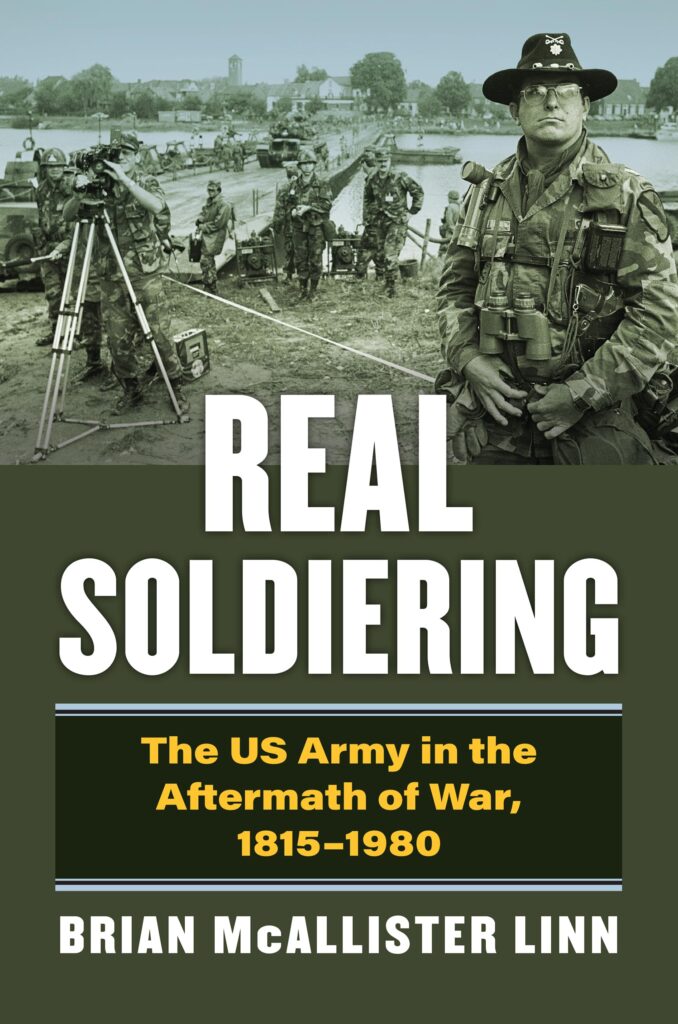By Brian McAllister Linn.
Lawrence: University Press of Kansas, 2023.
ISBN 978-0-7006-3475-0. Notes. Bibliography. Index.
Pp. xx, 300. $54.99.
Few military history books cover the less glamorous, yet incredibly important, periods of peace. Fewer still focus on how the U.S. Army, in particular, has developed over the various periods of peace in American history. In his book, Real Soldiering: The US Army in the Aftermath of War, 1815-1980, Brian McAllister Linn does just that. Linn presents a timely and masterful study focused on the challenges the Army faced in the decade following each major conflict from the War of 1812 to Vietnam.
Real Soldiering describes the difficult work of serving in uniform once hostilities cease. As his title suggests, Linn describes the work of the peacetime soldier as extremely challenging. Nonetheless, the organizational changes that occurred in the ranks during each of the periods he studies are critical to understanding what the Army is going through today.
Linn breaks each postwar decade into two halves, finding similarities in how the Army responded during each period. For the first five years following every major conflict, policymakers focused on “institutional reforms seek[ing] to apply the lessons of the recent war” (p. xiv). These changes focused on reforming “personnel, doctrine, organization, and mission to reposition the service within the current national defense policy” (p. xiv).
In the second half-decade, Linn shifts his focus away from Washington and into the field as leaders throughout the force attempted to apply the superabundance of policy and institutional changes newly imposed on the organization. He finds that leaders throughout his period of study faced largely the same challenges and frustrations as they attempted to implement newly imposed reforms. Severe manpower shortages, outdated and poorly maintained equipment, low morale, and poor discipline proved to be perennial problems. As a result, the policies dreamed up in Washington were not always put into practice as easily or effectively as intended. Nonetheless, Linn describes how junior leaders reacted to the changes coming down from their superiors and brought them to fruition to the best of their ability, amidst the many challenges faced by the “hollow army” in the field.
For his sources, Linn drew upon much more than official documents by including such personal sources as diaries, letters, memoirs, oral histories, and other similar documents that show the perspective of those in the middle and lower ranks. He also cites numerous officers’ student papers and professional journal articles, which gives wonderful insight into the thoughts of junior officers from the period.
In his conclusion, Linn offers some brief commentary on more recent events, including the current state of the Army, albeit with the appropriate caveats from a scholar focused on the past rather than the present. Linn suggests that the post-Gulf War and the post-Global War on Terrorism periods conformed to the same pattern as before. He suggests that the Army today is transitioning from the first half-decade into the second following the Global War on Terrorism. As such, we should expect to see a slowdown in policy and doctrinal changes from the Pentagon and can expect to see leaders in the field over the next five years struggling to implement these new changes while facing budgetary constraints, manpower shortages, inadequate equipment, low morale, and other difficulties.
Many historians have heaped praise on the heroes of the past. Now, Linn brings some much-needed recognition to the peacetime soldiers who, through much difficult and thankless work, ensured the Army kept rolling along. As Linn so eloquently shows, from 1815 to today, one “great constant remained: soldiering in the aftermath of war was a tough business” (p. 194). Real Soldiering is highly recommended for policymakers, military scholars, as well as soldiers currently serving who are likely facing some of the same challenges Linn describes. Those who find an interest in Real Soldiering should also pick up a copy of Linn’s The Echo of Battle: The Army’s Way of War. Both are excellent titles which firmly place Linn as one of today’s preeminent scholars of the U.S. Army.
Major Jeb S. Graydon, USA
Joint Base McGuire-Dix-Lakehurst, New Jersey
